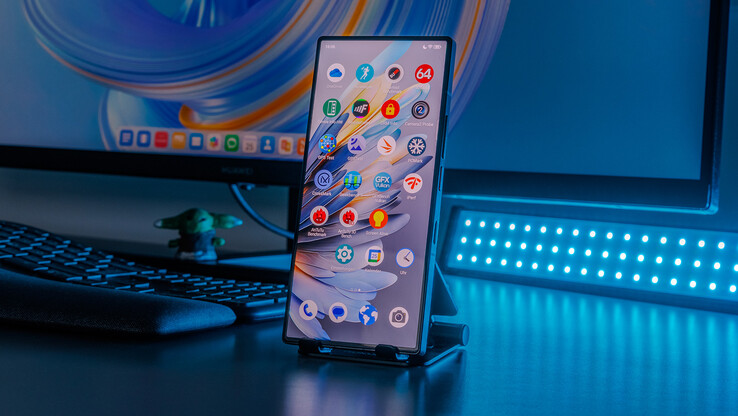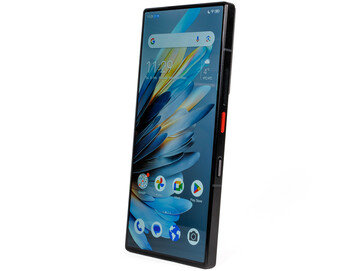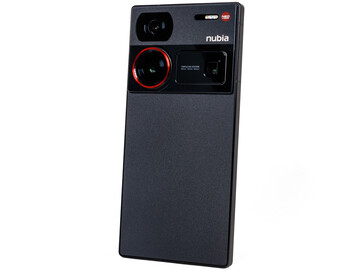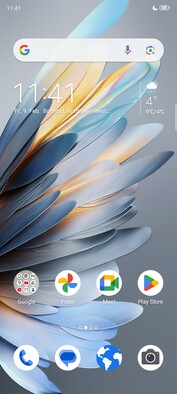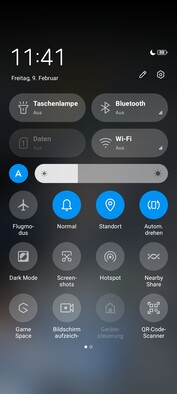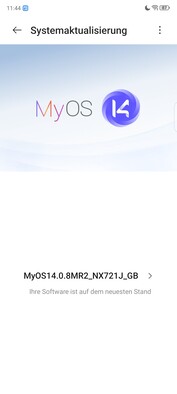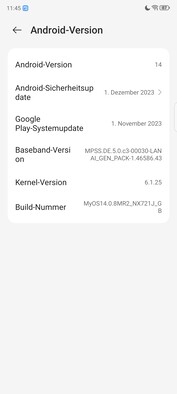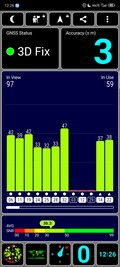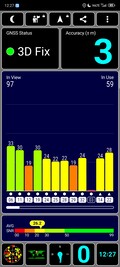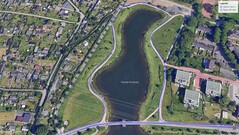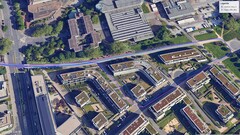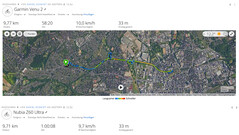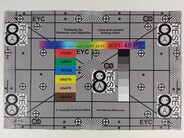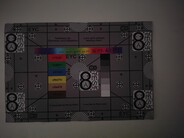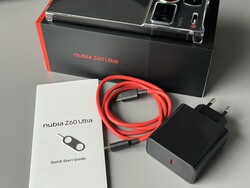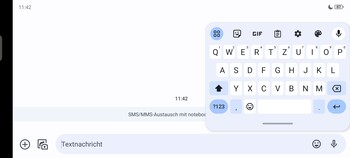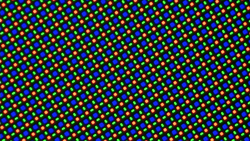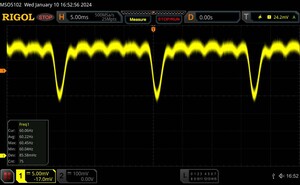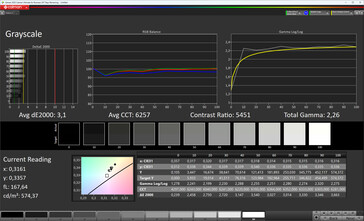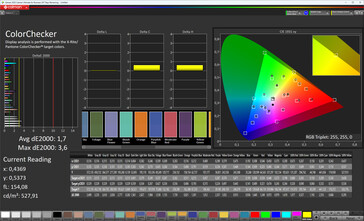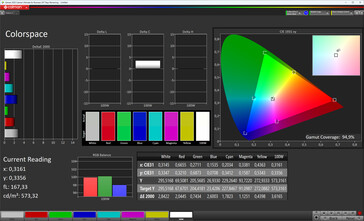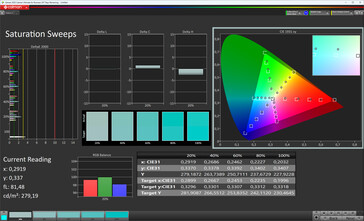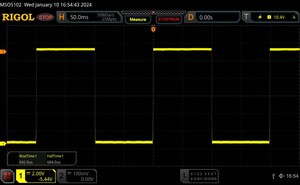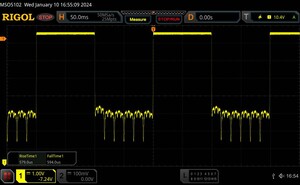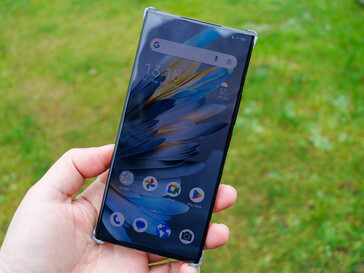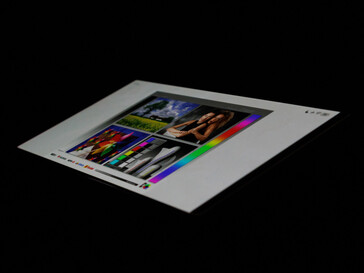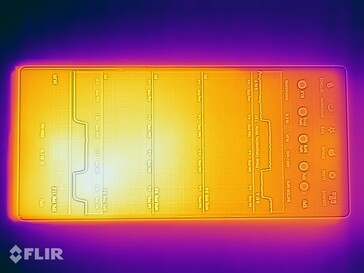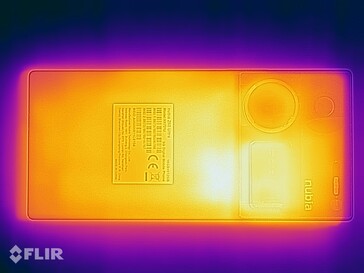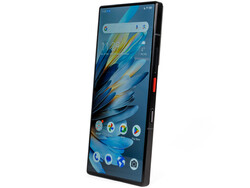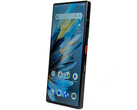Nubia Z60 Ultra review - Premium smartphone with a small price tag and unique camera
After the Nubia Z50 Ultra failed to get an official worldwide release and was only available as an import device, there is finally a global version of the Z60 Ultra. The company, which is associated with ZTE, retains the striking design of the predecessor and again offers a camera system with relatively unique focal lengths.
Other than the really fast Snapdragon 8 Gen 3, which is also used in Nubia’s own gaming phone RedMagic 9 Pro, the Z60 Ultra aims to win over consumers with IP certification, lots of memory and storage, a large battery and especially an affordable starting price of just €679 (US$599). Read our review to find out whether the Nubia phone will become a flagship killer 2024.
Comparison with possible competitors
Rating | Date | Model | Weight | Drive | Size | Resolution | Price |
|---|---|---|---|---|---|---|---|
| 86.8 % v7 (old) | 02 / 2024 | Nubia Z60 Ultra SD 8 Gen 3, Adreno 750 | 246 g | 512 GB UFS 4.0 Flash | 6.80" | 2480x1116 | |
| 91.1 % v7 (old) | 12 / 2023 | Apple iPhone 15 Pro Max A17 Pro, A17 Pro GPU | 221 g | 256 GB NVMe | 6.70" | 2796x1290 | |
| 89 % v7 (old) | 12 / 2023 | Google Pixel 8 Pro Tensor G3, Mali-G715 MP7 | 213 g | 128 GB UFS 3.1 Flash | 6.70" | 2992x1344 | |
| 89.4 % v7 (old) | 12 / 2023 | Xiaomi 14 Pro SD 8 Gen 3, Adreno 750 | 223 g | 256 GB UFS 4.0 Flash | 6.73" | 3200x1440 |
Chassis - Nubia Z60 Ultra with a distinctive design
The Nubia Z60 Ultra has a fairly boxy design with a very prominent camera setup on the back. The device is relatively heavy at 246 g (0.54 lb), but sits well in the hand and also isn’t top-heavy. Thanks to its dark aluminium frame and matt back glass, fingerprints hardly stand a chance.
We really like the Z60 Ultra’s build quality. Nothing creaks, wiggles or has too much give. Gaps are small and even. The front is protected by Corning Gorilla Glass 5. The phone is also dust-tight and waterproof according to IP68.
The Nubia Z60 Ultra is available in silver and black.
Specifications - USB 3.2 and IR blaster are on board
Nubia offers three versions of the phone for the global market:
| RAM/Storage | Colours | Price |
|---|---|---|
| 8/256 GB | Black | €679/US$599 |
| 12/256 GB | Black or silver | €749/US$649 |
| 16/512 GB | Black or Silver | €899/US$779 |
Even though Nubia has priced the base model very affordably, you’ll need to be prepared to fork out a hefty premium if you need for more storage, especially since it’s not possible to add a microSD card.
Whilst the company hasn’t provided detailed specs of the USB port, the high data transfer speeds in our copy test (888.84 MB/s) suggest that it’s a USB 3.2 Gen 2 interface, particularly given that it supports video output at Ultra HD over a cable. The interface also has USB-OTG capability; storage devices connected to the phone can be formatted in FAT32, exFAT or NTFS.
In any case, the Z60 Ultra comes with a well-rounded set of features: NFC, Bluetooth 5.4 and an IR blaster are all on board as well.
Software - Currently on Android 14, but only a few updates
The Z60 Ultra is currently on Google Android 14 with the Nubia's MyOS 14 custom UI on top it. At the time of this review, the security patches were dated 1 December 2023 and thus still fairly up-to-date. Nubia hasn’t released further details regarding update intervals, but aims to provide up to three years of support. Nothing has been said about the number of major updates for the device. It is still up in the air whether there is going to be more than one.
Connectivity and GNSS - Z60 Ultra is capable of 6 GHz Wi-Fi
As far as cellular connectivity goes, the Nubia Z60 Ultra is compatible with all current standards (including 5G Sub-6) and a wide range of frequency bands. In our review, the phone demonstrated great reception in a metropolitan environment.
The Z60 Ultra supports the latest Wi-Fi 7 standard and can also operate in the 6 GHz band. It was able to achieve high and largely stable transfer speeds in conjunction with our reference router, the Asus ROG Rapture GT-AXE11000.
| Networking | |
| Nubia Z60 Ultra | |
| iperf3 receive AXE11000 | |
| iperf3 transmit AXE11000 | |
| iperf3 transmit AXE11000 6GHz | |
| iperf3 receive AXE11000 6GHz | |
| Apple iPhone 15 Pro Max | |
| iperf3 receive AXE11000 | |
| iperf3 transmit AXE11000 | |
| iperf3 transmit AXE11000 6GHz | |
| iperf3 receive AXE11000 6GHz | |
| Google Pixel 8 Pro | |
| iperf3 receive AXE11000 | |
| iperf3 transmit AXE11000 | |
| iperf3 transmit AXE11000 6GHz | |
| iperf3 receive AXE11000 6GHz | |
| Xiaomi 14 Pro | |
| iperf3 receive AXE11000 | |
| iperf3 transmit AXE11000 | |
| iperf3 transmit AXE11000 6GHz | |
| iperf3 receive AXE11000 6GHz | |
| Average of class Smartphone | |
| iperf3 receive AXE11000 | |
| iperf3 transmit AXE11000 | |
| iperf3 transmit AXE11000 6GHz | |
| iperf3 receive AXE11000 6GHz | |
The Nubia phone has great positioning capability and can find its own location very quickly and accurately outdoors. In buildings, despite the signal begin considerably weaker, the phone can still identify its location with accuracy.
We went on a bike ride to compare the Nubia phone against a Garmin Venu 2 fitness smartwatch. The two devices produced fairly close results, though the Z60 Ultra was even more accurate in some sections.
Call function and voice quality
Although the Z60 Ultra is a dual-SIM phone with space for two nano SIM cards, it doesn’t support eSIMs. It is compatible with VoLTE but not Wi-Fi calling.
Voices are readily intelligible when the device is held to the ear. However, background noise suppression only works moderately well. The speakerphone stands out with a pretty long microphone range, but the user’s voice is accompanied by an audible noise.
Cameras - Unique triple camera setup with decent imaging performance
The Nubia Z60 Ultra has an under-display front camera to give the screen a seamless design. This camera can only be seen under appropriate lighting conditions and upon close examination, but leaves something to be desired quality-wise. Photos taken with the camera appear somewhat dull and washed out, and it can only record videos at up to Full HD (30 fps).
Nubia has taken a different route with the main camera module’s focal distances, opting for rather unique lengths. For instance, the main shooter uses 35 mm (35 mm equivalent) instead of the typical 24 or 26 mm, which moves the subject closer to the lens. This actually doesn’t bother us at all; in fact, we really like it during our testing. Imaging performance is likewise decent, with quality suffering slightly only in difficult lighting conditions. You can see this in the picture of the bunny: the bright areas have a tendency to be blown out. In the lake scene, however, the Z60 Ultra managed to produce a highly dynamic photo rich in detail.
The ultra-wide camera has a longer focal length as well (18 mm). This is good for quality but causes the field of view to be substantially smaller. This lens can also be used for macro photography.
The telephoto lens similarly delivers great results and has a 2.4x zoom (85 mm). When using digital zoom, you’ll notice that a 5x zoom moves you much closer to the subject and gives you an equivalent focal length of 170 mm, instead of the usual 120 mm. The camera is capable of reaching up to a 30x zoom (1,000 mm). All three lenses are also equipped with optical image stabilisation (OIS). There is a Pro mode with RAW support as well.
Videos can be recorded at 8K (30 fps). Frame rates can even go as high as 120 fps at Ultra HD or lower.
Image comparison
Choose a scene and navigate within the first image. One click changes the position on touchscreens. One click on the zoomed-in image opens the original in a new window. The first image shows the scaled photograph of the test device.
Main cameraMain cameraUltra-wide camera5x zoomLow-light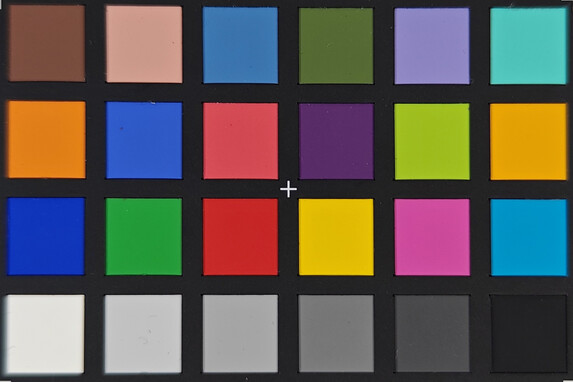
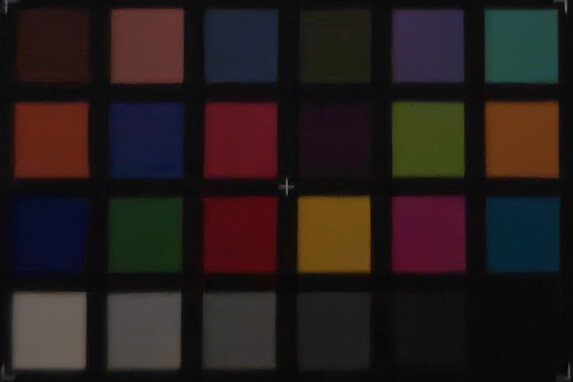
Accessories and warranty - Comprehensive box contents
In the EU, Nubia provides a 24-month warranty on the international version of the Z60 Ultra without any extension options. Please note the warranty period may vary by region.
Inside the box, you’ll find a modular 80-watt charger, a USB-C cable, a clear plastic protective case, a SIM ejector tool and a quick start guide. But Nubia doesn’t sell any optional accessories.
Input devices & operation - Z60 Ultra with slider switch
The capacitive touchscreen on the Nubia Z60 Ultra can detect up to ten points of contact at the same time and comes pre-installed with a screen protector. The surface is nice and smooth, and the entire display responds swiftly and precisely to inputs.
A linear vibration motor provides crisp feedback and is pleasantly quiet to boot. Biometric security is handled by an optical fingerprint scanner in the display. It does its job reliably and unlocks the phone in no time. You can also use face recognition via the front camera as an supplementary or alternative authentication method.
By default, the slider on the right side can be used to immediately open the camera in Street mode. Nevertheless, its function can be modified in the settings (see screenshot).
Display - Seamless AMOLED at 120Hz
Measuring 6.8 inches diagonally, the AMOLED display on the Nubia Z60 Ultra uses a Full HD+ resolution and produces a sharp image. It has a high touch sampling rate of 960Hz and a refresh rate of 120Hz. But the screen isn’t an LTPO panel, meaning the system can only switch automatically between 60Hz and 120Hz. Alternatively, you have the option to lock the display at either of the refresh rates.
Support for HDR standards is somewhat skimpy because all you get is HLG and HDR10 – that’s it. On the other hand, with the ambient light sensor enabled, the display has a pleasantly high peak brightness when showing a completely white image, reaching 1,003 cd/m² in the middle. That said, we weren’t able to hit the 1,500 cd/m² peak brightness claimed by Nubia, neither with APL 18 (1,190 cd/m²) nor during HDR playback (1,204 cd/m²). For manual brightness control, you have up to 577 cd/m² at your disposal.
On the oscilloscope, the OLED display flickered at a constant 60Hz and showed a very homogeneous amplitude waveform. Nubia mentioned a PWM dimming at up to 2,160Hz, which is something we can likewise confirm using our flicker meter. As a result, the display should be relatively easy on the eyes and not cause any complaints.
| |||||||||||||||||||||||||
Brightness Distribution: 96 %
Center on Battery: 1003 cd/m²
Contrast: ∞:1 (Black: 0 cd/m²)
ΔE ColorChecker Calman: 1.7 | ∀{0.5-29.43 Ø4.77}
ΔE Greyscale Calman: 3.1 | ∀{0.09-98 Ø5}
94.9% sRGB (Calman 2D)
Gamma: 2.26
CCT: 6257 K
| Nubia Z60 Ultra AMOLED, 2480x1116, 6.8" | Apple iPhone 15 Pro Max OLED, 2796x1290, 6.7" | Google Pixel 8 Pro OLED, 2992x1344, 6.7" | Xiaomi 14 Pro AMOLED, 3200x1440, 6.7" | |
|---|---|---|---|---|
| Screen | 20% | 28% | 15% | |
| Brightness middle (cd/m²) | 1003 | 1102 10% | 1510 51% | 1025 2% |
| Brightness (cd/m²) | 1001 | 1102 10% | 1467 47% | 1046 4% |
| Brightness Distribution (%) | 96 | 98 2% | 92 -4% | 95 -1% |
| Black Level * (cd/m²) | ||||
| Colorchecker dE 2000 * | 1.7 | 1.1 35% | 1.1 35% | 1.1 35% |
| Colorchecker dE 2000 max. * | 3.6 | 3.1 14% | 3.8 -6% | 2.9 19% |
| Greyscale dE 2000 * | 3.1 | 1.6 48% | 1.7 45% | 2.2 29% |
| Gamma | 2.26 97% | 2.19 100% | 2.23 99% | 2.25 98% |
| CCT | 6257 104% | 6555 99% | 6670 97% | 6622 98% |
* ... smaller is better
Screen Flickering / PWM (Pulse-Width Modulation)
| Screen flickering / PWM detected | 60 Hz | ||
The display backlight flickers at 60 Hz (worst case, e.g., utilizing PWM) . The frequency of 60 Hz is very low, so the flickering may cause eyestrain and headaches after extended use. In comparison: 53 % of all tested devices do not use PWM to dim the display. If PWM was detected, an average of 8084 (minimum: 5 - maximum: 343500) Hz was measured. | |||
The colour analysis performed with Calman verified the Nubia Z60 Ultra’s great results. The default settings actually produced the best values and also uses the larger DCI-P3 gamut.
Display Response Times
| ↔ Response Time Black to White | ||
|---|---|---|
| 1.38 ms ... rise ↗ and fall ↘ combined | ↗ 0.692 ms rise | |
| ↘ 0.684 ms fall | ||
| The screen shows very fast response rates in our tests and should be very well suited for fast-paced gaming. In comparison, all tested devices range from 0.1 (minimum) to 240 (maximum) ms. » 7 % of all devices are better. This means that the measured response time is better than the average of all tested devices (20.2 ms). | ||
| ↔ Response Time 50% Grey to 80% Grey | ||
| 1.17 ms ... rise ↗ and fall ↘ combined | ↗ 0.579 ms rise | |
| ↘ 0.594 ms fall | ||
| The screen shows very fast response rates in our tests and should be very well suited for fast-paced gaming. In comparison, all tested devices range from 0.165 (minimum) to 636 (maximum) ms. » 4 % of all devices are better. This means that the measured response time is better than the average of all tested devices (31.6 ms). | ||
The Z60 Ultra leaves a great impression outdoors, with the screen remaining decently readable in most lighting situations. The only thing is that reflections on the display’s surface can lightly affect readability when the screen is viewed at a slight angle.
The viewing angle is superb as such. And there aren't any colour shifts even if the screen is viewed from a very sharp angle, but the brightness does roll off a little.
Performance - Plenty of power thanks to Snapdragon 8 Gen 3
The Nubia Z60 Ultra is powered by the latest Snapdragon 8 Gen 3 and can be kitted out with 8, 12 or 16 GB of memory, depending on the configuration you choose. The phone runs as fast as you might expect and can even slightly outperform its actively cooled cousin, the RedMagic 9 Pro, in many aspects.
The UFS 4.0 storage likewise operates at a very high level and enables the Z60 Ultra to have smooth system performance. The smartphone is snappy during web browsing, but it doesn’t get along well with Google Chrome in benchmarks. Consequently, we ran the benchmarks using Microsoft Edge.
| Antutu v9 - Total Score | |
| Average Qualcomm Snapdragon 8 Gen 3 (1468882 - 1650926, n=5) | |
| Google Pixel 8 Pro | |
| Average of class Smartphone (99654 - 2056989, n=24, last 2 years) | |
| Xiaomi 14 Pro | |
| PCMark for Android - Work 3.0 | |
| Nubia Z60 Ultra | |
| Average Qualcomm Snapdragon 8 Gen 3 (12156 - 25683, n=28) | |
| Xiaomi 14 Pro | |
| Average of class Smartphone (4507 - 28557, n=184, last 2 years) | |
| Google Pixel 8 Pro | |
| UL Procyon AI Inference for Android - Overall Score NNAPI | |
| Google Pixel 8 Pro | |
| Average of class Smartphone (3769 - 81594, n=132, last 2 years) | |
| Nubia Z60 Ultra | |
| Xiaomi 14 Pro | |
| Average Qualcomm Snapdragon 8 Gen 3 (11487 - 18370, n=22) | |
Graphics processing is handled by an integrated Adreno 750, which is able to run at peak form in the Nubia Z60 Ultra. Particularly in GFXBench’s 4K test, the phone is able to pull ahead slightly further and thus offers the best attributes for gaming.
GFXBench (DX / GLBenchmark) 2.7: T-Rex Onscreen | 1920x1080 T-Rex Offscreen
GFXBench 3.0: on screen Manhattan Onscreen OGL | 1920x1080 1080p Manhattan Offscreen
GFXBench 3.1: on screen Manhattan ES 3.1 Onscreen | 1920x1080 Manhattan ES 3.1 Offscreen
GFXBench: on screen Car Chase Onscreen | 1920x1080 Car Chase Offscreen | on screen Aztec Ruins High Tier Onscreen | 2560x1440 Aztec Ruins High Tier Offscreen | on screen Aztec Ruins Normal Tier Onscreen | 1920x1080 Aztec Ruins Normal Tier Offscreen | 3840x2160 4K Aztec Ruins High Tier Offscreen
| 3DMark / Wild Life Extreme Unlimited | |
| Nubia Z60 Ultra | |
| Apple iPhone 15 Pro Max | |
| Google Pixel 8 Pro | |
| 3DMark / Wild Life Extreme | |
| Nubia Z60 Ultra | |
| Apple iPhone 15 Pro Max | |
| Google Pixel 8 Pro | |
| 3DMark / Wild Life Unlimited Score | |
| Nubia Z60 Ultra | |
| Apple iPhone 15 Pro Max | |
| Google Pixel 8 Pro | |
| 3DMark / Wild Life Score | |
| Google Pixel 8 Pro | |
| 3DMark / Sling Shot Extreme (ES 3.1) Unlimited Physics | |
| Google Pixel 8 Pro | |
| 3DMark / Sling Shot Extreme (ES 3.1) Unlimited Graphics | |
| Google Pixel 8 Pro | |
| 3DMark / Sling Shot Extreme (ES 3.1) Unlimited | |
| Google Pixel 8 Pro | |
| GFXBench (DX / GLBenchmark) 2.7 / T-Rex Onscreen | |
| Google Pixel 8 Pro | |
| Xiaomi 14 Pro | |
| Apple iPhone 15 Pro Max | |
| Nubia Z60 Ultra | |
| GFXBench (DX / GLBenchmark) 2.7 / T-Rex Offscreen | |
| Nubia Z60 Ultra | |
| Xiaomi 14 Pro | |
| Apple iPhone 15 Pro Max | |
| Google Pixel 8 Pro | |
| GFXBench 3.0 / Manhattan Onscreen OGL | |
| Google Pixel 8 Pro | |
| Xiaomi 14 Pro | |
| Apple iPhone 15 Pro Max | |
| Nubia Z60 Ultra | |
| GFXBench 3.0 / 1080p Manhattan Offscreen | |
| Nubia Z60 Ultra | |
| Xiaomi 14 Pro | |
| Apple iPhone 15 Pro Max | |
| Google Pixel 8 Pro | |
| GFXBench 3.1 / Manhattan ES 3.1 Onscreen | |
| Xiaomi 14 Pro | |
| Google Pixel 8 Pro | |
| Apple iPhone 15 Pro Max | |
| Nubia Z60 Ultra | |
| GFXBench 3.1 / Manhattan ES 3.1 Offscreen | |
| Nubia Z60 Ultra | |
| Xiaomi 14 Pro | |
| Apple iPhone 15 Pro Max | |
| Google Pixel 8 Pro | |
| GFXBench / Car Chase Onscreen | |
| Xiaomi 14 Pro | |
| Google Pixel 8 Pro | |
| Apple iPhone 15 Pro Max | |
| Nubia Z60 Ultra | |
| GFXBench / Car Chase Offscreen | |
| Nubia Z60 Ultra | |
| Xiaomi 14 Pro | |
| Apple iPhone 15 Pro Max | |
| Google Pixel 8 Pro | |
| GFXBench / Aztec Ruins High Tier Onscreen | |
| Xiaomi 14 Pro | |
| Google Pixel 8 Pro | |
| Nubia Z60 Ultra | |
| Apple iPhone 15 Pro Max | |
| GFXBench / Aztec Ruins High Tier Offscreen | |
| Nubia Z60 Ultra | |
| Xiaomi 14 Pro | |
| Apple iPhone 15 Pro Max | |
| Google Pixel 8 Pro | |
| GFXBench / Aztec Ruins Normal Tier Onscreen | |
| Xiaomi 14 Pro | |
| Google Pixel 8 Pro | |
| Nubia Z60 Ultra | |
| Apple iPhone 15 Pro Max | |
| GFXBench / Aztec Ruins Normal Tier Offscreen | |
| Nubia Z60 Ultra | |
| Xiaomi 14 Pro | |
| Apple iPhone 15 Pro Max | |
| Google Pixel 8 Pro | |
| GFXBench / 4K Aztec Ruins High Tier Offscreen | |
| Nubia Z60 Ultra | |
| Xiaomi 14 Pro | |
| Apple iPhone 15 Pro Max | |
| Google Pixel 8 Pro | |
| Jetstream 2 - 2.0 Total Score | |
| Apple iPhone 15 Pro Max (Safari Mobile 17) | |
| Nubia Z60 Ultra (Edge 120) | |
| Nubia Z60 Ultra (Chrome 121) | |
| Xiaomi 14 Pro (Chrome 120) | |
| Average Qualcomm Snapdragon 8 Gen 3 (64.1 - 241, n=24) | |
| Average of class Smartphone (23.8 - 387, n=147, last 2 years) | |
| Google Pixel 8 Pro (Chrome 117) | |
| WebXPRT 4 - Overall | |
| Xiaomi 14 Pro (Chrome 120) | |
| Nubia Z60 Ultra (Edge 120) | |
| Average Qualcomm Snapdragon 8 Gen 3 (69 - 212, n=22) | |
| Average of class Smartphone (27 - 306, n=143, last 2 years) | |
| Google Pixel 8 Pro (Chrome 117) | |
| Octane V2 - Total Score | |
| Apple iPhone 15 Pro Max (Safari Mobile 17) | |
| Nubia Z60 Ultra (Edge 120) | |
| Xiaomi 14 Pro (Chrome 120) | |
| Average Qualcomm Snapdragon 8 Gen 3 (25953 - 75238, n=27) | |
| Average of class Smartphone (2228 - 126661, n=194, last 2 years) | |
| Google Pixel 8 Pro (Chrome 117) | |
| Mozilla Kraken 1.1 - Total | |
| Average of class Smartphone (257 - 28190, n=154, last 2 years) | |
| Google Pixel 8 Pro (Chrome 117) | |
| Xiaomi 14 Pro (Chrome 120) | |
| Average Qualcomm Snapdragon 8 Gen 3 (510 - 2066, n=25) | |
| Nubia Z60 Ultra (Edge 120) | |
| Apple iPhone 15 Pro Max (Safari Mobile 17) | |
* ... smaller is better
| Nubia Z60 Ultra | Google Pixel 8 Pro | Honor Magic5 Pro | Xiaomi 14 | Average 512 GB UFS 4.0 Flash | Average of class Smartphone | |
|---|---|---|---|---|---|---|
| AndroBench 3-5 | -71% | -35% | -15% | -17% | -45% | |
| Sequential Read 256KB (MB/s) | 3926.73 | 1501.13 -62% | 3344.12 -15% | 3385.74 -14% | 3689 ? -6% | 2235 ? -43% |
| Sequential Write 256KB (MB/s) | 3518.47 | 257.28 -93% | 2651.87 -25% | 2906.65 -17% | 3092 ? -12% | 1871 ? -47% |
| Random Read 4KB (MB/s) | 477.73 | 156.16 -67% | 267.91 -44% | 420.99 -12% | 385 ? -19% | 297 ? -38% |
| Random Write 4KB (MB/s) | 701.13 | 258.92 -63% | 298.31 -57% | 594.78 -15% | 474 ? -32% | 343 ? -51% |
Emissions - Dual speakers in the Nubia Z60 Ultra
Temperature
Skin temperatures on the Nubia Z60 Ultra can rise to a high level under load. This happened despite the fact that we were already forced to reduce the settings to pure CPU load in Burnout Benchmark, as otherwise the app would crash.
The device also experienced significant performance losses in 3Dmark stress tests, but still remained faster than an iPhone 15 Pro Max.
(-) The maximum temperature on the upper side is 47 °C / 117 F, compared to the average of 35.2 °C / 95 F, ranging from 21.9 to 247 °C for the class Smartphone.
(-) The bottom heats up to a maximum of 46.5 °C / 116 F, compared to the average of 34 °C / 93 F
(+) In idle usage, the average temperature for the upper side is 25.7 °C / 78 F, compared to the device average of 32.9 °C / 91 F.
3DMark Wild Life stress test
| 3DMark | |
| Wild Life Stress Test Stability | |
| Apple iPhone 15 Pro Max | |
| Google Pixel 8 Pro | |
| Nubia Z60 Ultra | |
| Wild Life Extreme Stress Test | |
| Nubia Z60 Ultra | |
| Google Pixel 8 Pro | |
| Apple iPhone 15 Pro Max | |
| Solar Bay Stress Test Stability | |
| Nubia Z60 Ultra | |
| Apple iPhone 15 Pro Max | |
Speakers
Though the two speakers on the Z60 Ultra can get very loud, they have a really narrow sound stage and start distorting at high volume levels. The quality on offer is certainly good enough for occasional audio playback, but using external playback devices is recommended if you want to consume media more intensively.
Wired headphones can be connected to the USB-C port. For wireless devices, there is Bluetooth available with support for a wide range of codecs: SBC, AAC, aptX, aptX HD, aptX Adaptive, aptX TWS+, LDAC, LC3 and Opus.
Nubia Z60 Ultra audio analysis
(+) | speakers can play relatively loud (92.5 dB)
Bass 100 - 315 Hz
(-) | nearly no bass - on average 22.2% lower than median
(+) | bass is linear (5.8% delta to prev. frequency)
Mids 400 - 2000 Hz
(+) | balanced mids - only 4.4% away from median
(+) | mids are linear (4.8% delta to prev. frequency)
Highs 2 - 16 kHz
(±) | higher highs - on average 8.6% higher than median
(+) | highs are linear (6.1% delta to prev. frequency)
Overall 100 - 16.000 Hz
(±) | linearity of overall sound is average (19.7% difference to median)
Compared to same class
» 30% of all tested devices in this class were better, 8% similar, 62% worse
» The best had a delta of 11%, average was 35%, worst was 134%
Compared to all devices tested
» 49% of all tested devices were better, 7% similar, 44% worse
» The best had a delta of 4%, average was 24%, worst was 134%
Google Pixel 8 Pro audio analysis
(+) | speakers can play relatively loud (89.4 dB)
Bass 100 - 315 Hz
(-) | nearly no bass - on average 18.4% lower than median
(±) | linearity of bass is average (9.1% delta to prev. frequency)
Mids 400 - 2000 Hz
(±) | reduced mids - on average 5.2% lower than median
(+) | mids are linear (4.8% delta to prev. frequency)
Highs 2 - 16 kHz
(±) | higher highs - on average 6.4% higher than median
(+) | highs are linear (4.6% delta to prev. frequency)
Overall 100 - 16.000 Hz
(±) | linearity of overall sound is average (15.7% difference to median)
Compared to same class
» 4% of all tested devices in this class were better, 4% similar, 92% worse
» The best had a delta of 11%, average was 35%, worst was 134%
Compared to all devices tested
» 23% of all tested devices were better, 5% similar, 72% worse
» The best had a delta of 4%, average was 24%, worst was 134%
Battery life - 6,000 mAh for great stamina
Power consumption
The power consumption of the Nubia Z60 Ultra is at a low level. The comparatively high values under load were only observed at the beginning of the Burnout Benchmark running at our test settings. Power usage decreased significantly afterwards, with the phone eventually settling down at roughly 15 watts.
The 6,000 mAh battery can be charged at up to 80 watts over a wired connection, but wireless charging isn't supported.
| Off / Standby | |
| Idle | |
| Load |
|
Key:
min: | |
| Nubia Z60 Ultra 6000 mAh | Apple iPhone 15 Pro Max 4422 mAh | Google Pixel 8 Pro 5050 mAh | Xiaomi 14 Pro 4880 mAh | Average Qualcomm Snapdragon 8 Gen 3 | Average of class Smartphone | |
|---|---|---|---|---|---|---|
| Power Consumption | 20% | 23% | 26% | 2% | 16% | |
| Idle Minimum * (Watt) | 0.69 | 0.5 28% | 0.63 9% | 0.89 -29% | 0.969 ? -40% | 0.847 ? -23% |
| Idle Average * (Watt) | 1.52 | 1.97 -30% | 1.47 3% | 1.05 31% | 1.721 ? -13% | 1.448 ? 5% |
| Idle Maximum * (Watt) | 1.6 | 1.99 -24% | 1.55 3% | 1.11 31% | 1.891 ? -18% | 1.633 ? -2% |
| Load Average * (Watt) | 14.73 | 3.36 77% | 8.45 43% | 9.03 39% | 8.91 ? 40% | 6.96 ? 53% |
| Load Maximum * (Watt) | 20.82 | 10.43 50% | 8.63 59% | 9.06 56% | 12.1 ? 42% | 11.3 ? 46% |
* ... smaller is better
Power consumption: Geekbench (150 cd/m²)
Power consumption: GFXBench (150 cd/m²)
Battery life
In terms of battery life, it’s all about going big. The battery is already pretty substantial with a capacity of 6,000 mAh. Even so, the phone still managed to wow us in our Wi-Fi test by delivering a disproportionately long battery life of more than 21 hours.
| Battery runtime - WiFi v1.3 | |
| Nubia Z60 Ultra | |
| Apple iPhone 15 Pro Max | |
| Google Pixel 8 Pro | |
| Xiaomi 14 Pro | |
Pros
Cons
Verdict - Outstanding, but not the best
With the Z60 Ultra, Nubia is offering a very exciting phone that stands out with a number of high-end features and thus represents an attractive overall package with a low entry price. Apart from the snappy Snapdragon 8 Gen 3, the seamless AMOLED display is worth mentioning too. The device also features very long battery life, support for fast data transfer standards, and IP68 certification.
The Nubia Z60 Ultra is a fantastic option, but storage upgrades come at steep prices.
That said, the phone doesn’t quite have what it takes to be a flagship killer. On the technical side, Nubia Z60 Ultra isn’t able to fully reach the advertised peak brightness and can also get very warm under load. Though the under-display front camera allows for a notch- and hole-free design, its image quality isn't anything to call home about. Users will likewise have to do without wireless charging and eSIM support.
Update support is also fairly short. It’s not just the Pixel 8 that can do better, most high-end phones released last year still offer longer support periods than the Z60 Ultra. The Motorola Edge 40 Pro is an alternative with a similar entry price.
Price and availability
Nubia Z60 Ultra
- 02/13/2024 v7 (old)
Daniel Schmidt
Transparency
The selection of devices to be reviewed is made by our editorial team. The test sample was provided to the author as a loan by the manufacturer or retailer for the purpose of this review. The lender had no influence on this review, nor did the manufacturer receive a copy of this review before publication. There was no obligation to publish this review. As an independent media company, Notebookcheck is not subjected to the authority of manufacturers, retailers or publishers.
This is how Notebookcheck is testing
Every year, Notebookcheck independently reviews hundreds of laptops and smartphones using standardized procedures to ensure that all results are comparable. We have continuously developed our test methods for around 20 years and set industry standards in the process. In our test labs, high-quality measuring equipment is utilized by experienced technicians and editors. These tests involve a multi-stage validation process. Our complex rating system is based on hundreds of well-founded measurements and benchmarks, which maintains objectivity. Further information on our test methods can be found here.




